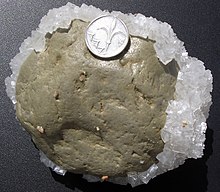Evaporite



Evaporite ( Latin evaporo , evaporate, evaporate ) describes a chemical sedimentary rock that forms in arid climates in sea or lake basins through precipitation due to an evaporation-related supersaturation of the water with dissolved minerals. Sediment sequences that either have a high proportion of evaporites or consist almost exclusively of evaporites are also referred to as saline .
Evaporite rocks consist of the so-called evaporite minerals, which are relatively easily soluble compounds from the mineral classes of chlorides and sulfates . The most common evaporite minerals are gypsum or anhydrite (both calcium sulfate ) and halite ( sodium chloride ).
Emergence
As the evaporation of a sea or lake basin progresses, the minerals are precipitated in the order of their solubility, starting with the minerals that are least soluble. They then form a sequence called the evaporation or saline cycle. The rock from the most difficultly soluble mineral ideally forms the basis of a cycle, and the rock from the most easily soluble minerals forms the top of a cycle:
- When the concentration is still relatively low, the carbonates precipitate and form limestone, which has often been subsequently converted into dolomite . However, since most limestones are not formed by precipitation from oversaturated solution, but are of direct or indirect biogenic origin , over the recent geological history and worldwide, limestone or dolomite is not part of the evaporites in the actual sense, but forms within the chemical sediments its own family of rocks. In an evaporite basin at the beginning of an evaporation cycle, the carbonate formation is presumably still predominantly biogenic at first and is then displaced by abiogenic precipitation due to the increasingly hostile conditions.
- The first “real” evaporite rock that forms with increasing concentration (approx. 3.5 times the normal salty sea water, concentrated in around 25% of the original amount of water) is gypsum. If these gypsum deposits are later sunk to a greater depth, the gypsum loses its crystal water and is converted into anhydrite. However, under extreme climatic conditions, anhydrite can also be precipitated directly. The largely monomineral sedimentary rock is called gypsum rock or gipsite or anhydrite rock or anhydritite
- Next, halite precipitates (concentration approx. 10 times, concentrated in approx. 10% of the original amount of water). The corresponding, largely monomineral sedimentary rock is called halitite .
- Finally (from a concentration of more than 100 times, concentrated in less than 1% of the original amount of water) the potassium and magnesium salts precipitate (including carnallite , sylvine , kainite ). These are also called potash salts, precious salts or, because they were not promoted before the discovery that they were ideally suited for fertilizer production, but were dumped on the spoil dump, spoil salts. The corresponding rocks are called, depending on the dominant precious salt mineral, u. a. Sylvinite or carnallite and are summarized in mining under the name potash salt .
As a rule, however, an evaporation cycle is not ideally structured, but rather has progressive layer sequences as well as recessive layer sequences; This means that evaporites from less soluble minerals sometimes overlay evaporites from more easily soluble minerals. Often the evaporation cycles are not complete, but end in the halite or gypsum phase, because the sea or lake never reached a concentration level that is necessary for the precipitation of precious salts due to the periodic supply of normal salt water or fresh water. Since the solubility products of calcite, gypsum, halite and precious salts are relatively far apart, these minerals only precipitate together in a narrow concentration window, whereby only limestone and gypsum, gypsum and halite as well as halite and precious salts precipitate together, but never limestone and halite or Gypsum and precious salts, since all the carbonate or gypsum has already been precipitated before the sodium chloride or the precious salts begin to precipitate.
The fact that evaporites precipitate from oversaturated seawater is used in seawater salines to extract sea salt by pumping the water into shallow basins and allowing it to evaporate with the help of solar radiation.
Occurrence
In comparison to limestone series or siliciclastic sequences, evaporite series are rather rare in geological tradition. The most important salinar series in Central Europe is the Zechstein series of the Upper Permian . Further salinar series in Central Europe can be found in the Upper Buntsandstein ( Röt -Salinar ), in the Middle Muschelkalk , in the Middle Keuper (" Gipskeuper ") and in the Eocene and Oligocene of the Upper Rhine Rift . The Upper Permian of Oklahoma and Texas as well as the western Ural foreland basin (“Pre-Ural”) in Russia also have powerful evaporation sequences. There are relatively young deposits in the Mediterranean Sea, which can be traced back to the so-called Messinian Salinity Crisis (MSC) in the recent Miocene .
literature
- Rudolf Hohl (ed.): The history of the development of the earth . 6th edition. Werner Dausien Verlag, Hanau 1985, ISBN 3-7684-6526-8 , p. 483 ff .
- Wolf von Engelhardt , Hans Füchtbauer , German Müller : Sediment Petrology. Volume 2: Hans Füchtbauer (Ed.): Sediments and sedimentary rocks. 4th, completely revised edition. Schweizerbart, Stuttgart 1988, ISBN 3-510-65138-3 .
- John K. Warren: Evaporites: Sediments, Resources and Hydrocarbons. Springer, Berlin / Heidelberg / New York 2006, ISBN 3-540-26011-0 .
Web links
Individual evidence
- ↑ Niels Bjerrum: Short textbook of inorganic chemistry. Springer, Berlin / Heidelberg 1933, ISBN 978-3-642-89291-2 (reprint), doi: 10.1007 / 978-3-642-91147-7 4 (chap. The light metals ), p. 249.